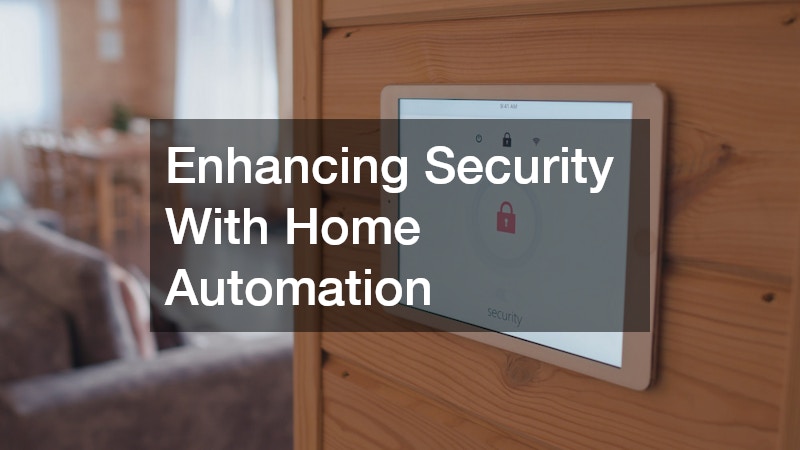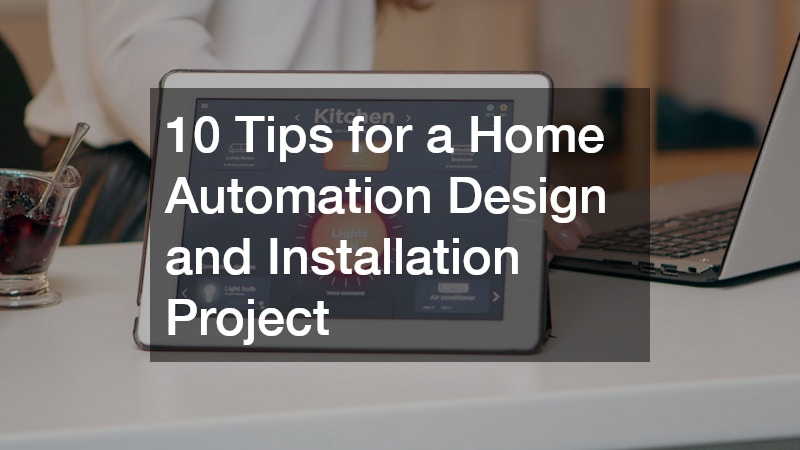In today’s fast-paced world, homeowners are constantly seeking new ways to simplify daily life while adding comfort, convenience, and efficiency to their living spaces. One of the most powerful solutions is home automation. By integrating smart technologies into your home, you can control lighting, climate, appliances, security, and entertainment systems with the touch of a button or even voice commands. Home automation design and installation is more than just a trend—it’s a way to revolutionize your lifestyle and bring harmony between technology and functionality.
Proper planning and execution are crucial when tackling a home automation design and installation project. From selecting compatible devices to working with professionals such as electrical contractors, HVAC repair services, and landscape lighting companies, each step requires careful thought and coordination. By approaching your project strategically, you can create a home that not only meets your immediate needs but is also adaptable to future advancements in technology.
Below, we’ll cover 10 key tips to guide you through your home automation journey and help you design a system tailored to your unique lifestyle.
1. Understanding the Basics of Home Automation

Before diving into the project, it’s important to fully grasp what home automation design and installation entail. At its core, home automation involves connecting various systems and devices to a central hub or network that allows you to control them remotely or automatically.
Some fundamental features of home automation include:
- Lighting control: Adjust brightness, schedules, and ambiance from a smartphone app or voice assistant.
- Climate control: Smart thermostats manage heating and cooling to optimize comfort and energy use.
- Security integration: Cameras, smart locks, and alarms provide real-time updates and peace of mind.
- Entertainment systems: Streamlined access to music, television, and streaming platforms in multiple rooms.
In addition to these essentials, specialized devices like motorized shades and awnings can enhance comfort and convenience. Imagine shades that automatically lower during peak sunlight hours to reduce heat inside your home or awnings that extend when rain is detected. Understanding how these pieces fit into the bigger picture sets a solid foundation for the rest of your project.
Taking time to understand the basics also prevents overcomplication. Some homeowners may be tempted to buy every new gadget available, but simplicity often leads to better functionality. By learning how individual devices connect and interact, you can avoid redundancy and focus on solutions that truly add value to your daily routine.
2. Planning Your Home Automation Design
Planning is arguably the most important stage of any home automation design and installation project. Without a detailed roadmap, you risk overspending or installing systems that don’t work well together. Start by identifying your household’s priorities. Do you want to focus on energy efficiency, security, entertainment, or a balance of all three?
Consider creating a checklist of goals:
- Reduce utility costs with smart thermostats and water heaters.
- Improve security with cameras and motion sensors.
- Enhance convenience with centralized control of lighting and shades.
When incorporating appliances such as water heaters, think about how automation can help manage energy consumption. Smart water heaters, for example, can adjust heating times to off-peak hours or when you’re most likely to need hot water.
Mapping out the placement of devices and planning for wiring or wireless connections will also make your installation process smoother. Whether you live in a new build or an older home, careful planning ensures your system is both functional and scalable.
During the planning stage, it’s also wise to think about your home’s future needs. Technology will continue to advance, and your family’s lifestyle may change. By designing your automation system with flexibility in mind, you can expand or adapt without needing to overhaul everything later.
3. Selecting the Best Devices and Technologies
The market for smart home devices is vast, which makes choosing the right technology challenging. When selecting devices, keep compatibility and scalability in mind. A device that works well today should also be able to integrate with new technologies tomorrow.
Key considerations when selecting devices:
- Compatibility with your hub or controller (Amazon Alexa, Google Home, Apple HomeKit, etc.).
- User-friendly interfaces that simplify control for all household members.
- Energy-saving capabilities that reduce costs in the long run.
- Reliability and customer support for troubleshooting.
Consulting with electrical contractors can also be beneficial during this stage. They can help determine whether your home’s wiring and electrical systems can handle additional smart devices. For example, adding automated lighting, outlets, or large appliances might require upgrades to your electrical system. By working with professionals, you can avoid costly mistakes and guarantee safety throughout the project.
It’s also a good idea to invest in devices from reputable manufacturers. While budget-friendly options may be tempting, low-quality products often lead to connection issues, limited functionality, or the lack of long-term support. Think of your home automation system as an investment—it should deliver reliable performance for years, not just until the next update.
4. Choosing Proper Installation Procedures and Best Practices

Home automation design and installation requires more than just plugging in devices—it’s about creating a seamless and reliable network. Professional installation can prevent common issues like connectivity problems, wiring errors, or system malfunctions.
Some best practices for installation include:
- Secure wiring: Ensuring cables are properly installed and shielded prevents interference and hazards.
- Device placement: Position sensors, cameras, and thermostats for optimal performance.
- System testing: Verify that all devices communicate correctly before finalizing installation.
HVAC repair services can also play a crucial role in this phase. If you’re integrating climate control into your home automation system, technicians can align your HVAC system with smart thermostats and sensors. This ensures that the automation functions properly and efficiently, preventing future malfunctions.
Remember that installation is not only about technical setup but also about user experience. A well-installed system should feel intuitive, allowing every household member to interact with it comfortably. Paying attention to small details like convenient switch placement or clear labeling can make a significant difference in everyday use.
5. Integrating Different Systems Effectively
One of the greatest advantages of home automation is the ability to integrate multiple systems into one cohesive network. However, this can also be one of the most challenging aspects of the project.
Effective integration means that your lighting, security, HVAC, and entertainment systems all “speak” to each other. For example, when you arrive home, your garage door can trigger your indoor lights to turn on and your thermostat to adjust automatically.
A landscape lighting company can assist with outdoor automation, linking your exterior lights to your overall system. Imagine your garden lights, gate operator, and security cameras all activating together for added protection and convenience.
To achieve this level of integration, choose devices and software that support cross-platform compatibility. It’s often worth investing in higher-quality systems that offer seamless connectivity rather than settling for cheaper options that may not work together smoothly.
The beauty of integration lies in creating “scenes” that combine different systems into single commands. A bedtime routine, for instance, can automatically lock doors, lower shades, and adjust the thermostat. Thinking in terms of routines and experiences rather than individual devices makes your automation system more functional and enjoyable.
6. Maintaining Your Home Automation System
Once your system is installed, proper maintenance is essential to keep it running efficiently. Home automation design and installation is not a one-time project—it requires periodic updates and servicing.
Some maintenance tips include:
- Regularly updating software and firmware to keep devices secure and functioning properly.
- Cleaning and inspecting hardware such as cameras, sensors, and hubs.
- Testing backup systems like battery-powered locks or alarms.
- Scheduling professional inspections for more complex integrations.
A kitchen renovation company can even help integrate long-term maintenance into your design. For example, during a remodel, wiring and device placement can be set up with future upgrades in mind, reducing the need for disruptive work later. By maintaining your system proactively, you can extend its lifespan and reduce costly repairs.
Maintenance is also about anticipating upgrades. New devices often enter the market, offering better performance or additional features. By scheduling annual reviews of your system, you can identify opportunities to enhance functionality without starting from scratch.
7. Enhancing Security With Home Automation

Security remains one of the top reasons homeowners invest in automation. Home automation design and installation can transform traditional locks and alarms into sophisticated, integrated systems that provide real-time protection.
Some common security features include:
- Smart locks and video doorbells for controlled entry.
- Motion sensors that trigger alarms or lights.
- Gate operator installations for secure property access.
- Surveillance systems that allow remote monitoring.
Integrating gate operator installations with your home automation system adds an extra layer of control. You can open or close gates remotely, schedule automatic lock times, or receive alerts if suspicious activity is detected. By combining convenience with security, you can protect your property and loved ones while enjoying peace of mind.
Modern security automation also goes beyond traditional surveillance. With advanced analytics, your system can distinguish between a delivery driver and unusual activity. Features like facial recognition and AI-powered monitoring provide a proactive layer of protection, allowing your home to respond intelligently to potential threats.
8. Maximizing Energy Efficiency and Savings
Energy efficiency is not only good for the environment but also for your wallet. A thoughtfully designed home automation system can significantly cut down on utility costs.
Here are a few energy-saving automation ideas:
- Smart thermostats that learn your habits and adjust heating/cooling accordingly.
- Automated lighting that turns off when rooms are unoccupied.
- Motorized shades that reduce heat gain during summer and retain warmth in winter.
- Smart plugs that manage appliance energy use.
Local garage door repair professionals can also play a role in improving efficiency. For instance, an automated garage door can be linked to your HVAC system to prevent energy loss by alerting you when the door is left open. By maximizing automation’s potential, you can strike a balance between comfort and sustainability.
Beyond utility savings, energy-efficient automation can also increase your home’s resale value. Buyers are increasingly drawn to properties that feature eco-friendly and cost-saving technologies. By demonstrating lower monthly expenses, your smart systems can set your home apart in a competitive market.
9. Customizing User Experience and Functionality
No two households are the same, which is why personalization is key in home automation design and installation. Customizing how your system operates can make daily life smoother and more enjoyable.
Customization ideas include:
- Personalized scenes: Set up “movie night” or “bedtime” routines with one command.
- Multi-user profiles: Create settings that adapt to different family members’ preferences.
- Voice control integration: Adjust devices hands-free through voice assistants.
- Remote access: Manage your home from anywhere using smartphone apps.
Working with an appliance repair company can help optimize automation for everyday appliances. For example, you could schedule your dishwasher or washing machine to run during off-peak hours, lowering energy bills. Customization allows your home to function in ways that match your lifestyle, making automation feel like a natural extension of your routine.
The customization process should focus on usability as much as functionality. A system that feels complicated can discourage household members from using it. Tailoring interfaces, commands, and accessibility features ensures that everyone—from tech-savvy adults to children or elderly relatives—can comfortably interact with the system.
10. Considering Future Trends in Home Automation

Technology evolves quickly, and your system should be designed with the future in mind. While current devices already offer impressive functionality, tomorrow’s innovations will push the boundaries even further.
Some emerging trends include:
- Artificial intelligence (AI) integration for predictive automation.
- Increased focus on sustainability with solar-powered systems and energy-sharing networks.
- Advanced voice recognition with personalized commands for each household member.
- Enhanced security protocols as smart homes become more connected.
A residential electrician can advise on upgrades to your wiring or electrical systems to prepare for future devices. Future-proofing during the initial home automation design and installation process allows for smoother integration of new technologies without the need for major renovations.
Home automation design and installation is a valuable investment that can completely transform the way you live. From understanding the basics to planning, integrating, maintaining, and customizing your system, each step plays an important role in building a modern, efficient, and secure home. By collaborating with professionals like electrical contractors, HVAC repair services, and landscape lighting companies, you can create a system tailored to your needs today while keeping an eye on future advancements. With thoughtful design and proper installation, your home can become a space that combines technology, comfort, and convenience seamlessly.
